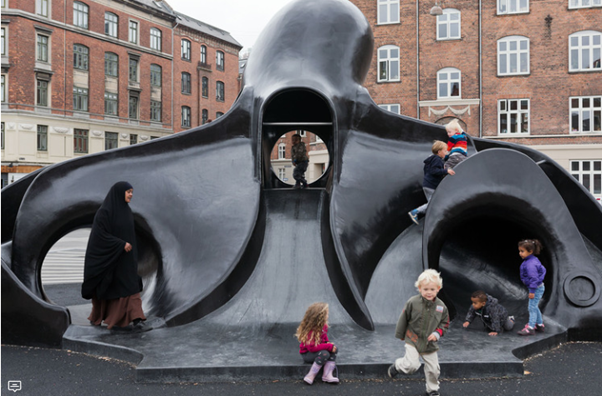Towards Child-Friendly Urban Spaces
Introduction
The rapid development of modern cities has brought numerous benefits, but it has also led to unintended consequences, particularly neglecting the needs of children in urban planning. Jacobs (1961) criticized that most city designs prioritize adults, resulting in a decline in spaces where children can safely play and explore. In reality, cities have become more focused on vehicle-centric traffic systems and commercial infrastructure, limiting opportunities for children to engage in play and social interactions.
Child-friendly urban design goes beyond merely providing playgrounds; its goal is to create inclusive environments where children can safely explore and be creative (Gill, 2021). Such design not only enhances children’s quality of life but also strengthens community bonds and promotes urban sustainability. This blog explores key elements and successful examples of child-friendly urban design to propose strategies for creating urban spaces that benefit everyone, including children.
Enhancing Safety and Accessibility for Children
Modern urbanization has prioritized traffic congestion solutions and commercial development, often at the expense of spaces for children to play and explore. Ensuring safety and accessibility in urban design is crucial for the healthy development of children.
According to Baldwin (2022), the Global Designing Cities Initiative (GDCI) introduced “Designing Streets for Kids,” a set of guidelines that focus on creating urban environments where children can move safely and explore freely.
For example, the Netherlands’ Woonerf system reduces vehicle speeds and prioritizes pedestrian-friendly streets, significantly decreasing pedestrian accidents involving children (Paja, 2015).

Figure_ Netherlands’ Woonerf system
Additionally, UNICEF (2004) emphasizes the importance of public spaces that are accessible to all residents, including children with disabilities. London’s Play Streets Initiative restricts traffic during certain hours, allowing children and families to play safely on the streets (London Borough of Hackney, 2020).
Promoting Creativity
Creative play is a critical element of child development (Gill, 2021). Barcelona’s Superblocks project, which restricts vehicle access and promotes pedestrian-centered spaces, has increased children’s playtime (Tonucci, 2005). This initiative provides a safe environment for children to engage in creative exploration even in the city center, fostering imaginative play.
Strengthening Community Bonds through Interaction
Child-friendly spaces play an essential role in strengthening community bonds. Gill (2021) notes that public spaces where children and parents can interact enhance social cohesion within the community.
In South Korea, the Village Square Project provides spaces for residents to gather, enabling children and parents to participate in community activities (Seoul Metropolitan Government, 2024). This approach fosters stronger community connections and improves residents’ quality of life.

Figure _ children’s park in Seoul
Integrated Case Study: Copenhagen’s Superkilen Park
Superkilen Park in Copenhagen is a prime example of integrating various cultural elements into an inclusive public space. It features wheelchair-accessible ramps and sensory play equipment, allowing people of all ages to enjoy the space together (ArchDaily, n.d.). The park promotes children’s play and creative exploration while strengthening social bonds, demonstrating how urban design can improve the quality of life for communities.

Figure_ Copenhagen’s Superkilen Park
Conclusion
In conclusion, child-friendly urban design should extend beyond simply building playgrounds. It aims to create safe and accessible urban environments that cater to children, families, and the broader community. Successful projects like the Woonerf system, Superblocks, and Superkilen Park show how urban planning can enhance the quality of life for children. Based on these examples, urban planners and policymakers must prioritize public spaces that reflect the needs of children and communities, fostering a more inclusive and sustainable urban future.
Reference list
ArchDaily. (n.d.). Superkilen / Topotek 1 + BIG Architects + Superflex. Available at: https://www.archdaily.com/286223/superkilen-topotek-1-big-architects-superflex. [Accessed: 9 November 2024].
Baldwin, E. (2022). 10 Actions to Improve Streets for Children. ArchDaily. Available at: https://www.archdaily.com/945350/10-actions-to-improve-streets-for-children. [Accessed: 9 November 2024].
Gill, T. (2021). Urban Playground: How Child-friendly Planning and Design Can Save Cities. RIBA Publishing.
Jacobs, J. (1961). The Death and Life of Great American Cities. Random House.
London Borough of Hackney. (2020). Hackney launches Play Streets scheme. Available at: https://news.hackney.gov.uk/hackney-launches-play-streets-scheme. [Accessed: 10 November 2024].
Paja, E. (2015). Evolvements of the Woonerf Concept and Design in Urban Planning. Available at: https://issuu.com/elvispaja/docs/elvis_paja__def_-_evolvements_of_th. [Accessed: 10 November 2024].
Seoul Metropolitan Government. (2024). Village Square Project revitalizes community spaces in Seoul. Available at: https://mediahub.seoul.go.kr/archives/2011175. [Accessed: 15 November 2024].
Tonucci, F. (2005). The Child-friendly City: Sustainable Development and Children. Earthscan.
UNICEF. (2004). Building Child Friendly Cities: A Framework for Action. UNICEF Innocenti Research Centre. Available at: https://www.unicef.de/_cae/resource/blob/23352/ad5bb58279edc5326ee6df29d5357933/-building-child-friendly-cities-a-framework-for-action–data.pdf. [Accessed: 11November 2024].






